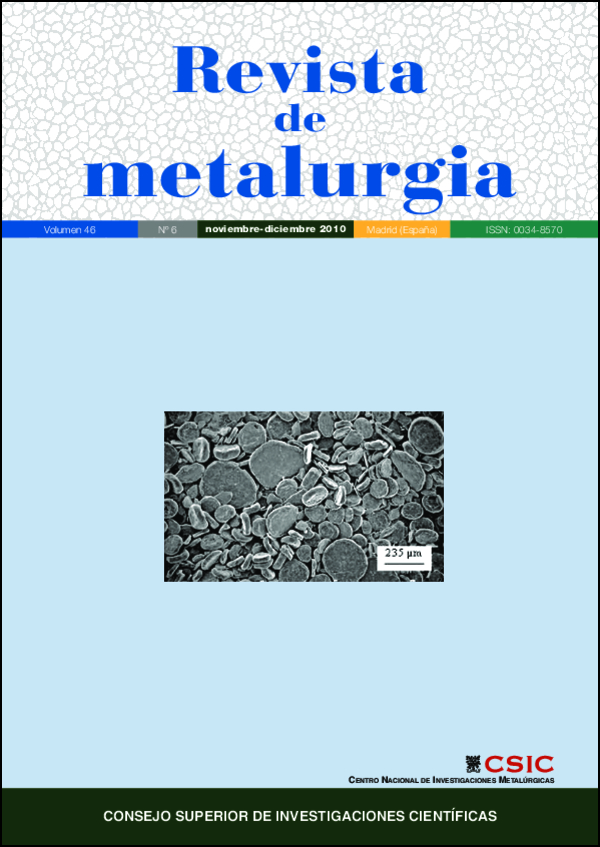A mathematical approach based on finite differences method for analyzing the temperature field in arc welding of stainless steel thin sheets
DOI:
https://doi.org/10.3989/revmetalmadrid.1021Keywords:
Numerical simulation of temperature field, Arc welding, Finite differences method, Temperature measure, Heat affected zoneAbstract
This work develops a finite difference method to evaluate the temperature field in the heat affected zone in butt welding applied to AISI 304 stainless steel thin sheet by GTAWprocess. A computer program has been developed and implemented by Visual Basic for Applications (VBA) in MS-Excel spreadsheet. The results that are obtained using the numerical application foresee the thermal behaviour of arc welding processes. An experimental methodology has been developed to validate the mathematical model that allows to measure the temperature in several points close to the weld bead. The methodology is applied to a stainless steel sheet with a thickness lower than 3 mm, although may be used for other steels and welding processes as MIG/MAG and SMAW. The data which has been obtained from the experimental procedure have been used to validate the results that have been calculated by the finite differences numerical method. The mathematical model adjustment has been carried out taking into account the experimental results. The differences found between the experimental and theoretical approaches are due to the convection and radiation heat losses, which have not been considered in the simulation model.With this simple model, the designer will be able to calculate the thermal cycles that take place in the process as well as to predict the temperature field in the proximity of the weld bead.
Downloads
References
[1] D. Rosenthal, Transactions ASME, 68 (1946) 849-1.946.
[2] D. Rosenthal, Weld. J. 20 (1941) 220-234.
[3] J.C. Suárez, Tesis Doctoral, Facultad de Ciencias Químicas, Universidad Complutense de Madrid, 1990.
[4] J.C. Suárez, E. Carrillo, and F. Molleda, Rev. Metal. Madrid 21 (1991) 65-72.
[5] J. C. Suárez, F. Molleda, and J. M. Gomez de Salazar, Mater. Charact. 28 (1992) 3-13. doi:10.1016/1044-5803(92)90024-C
[6] N.T. Nguyen, A. Ohta, K.Matsuoka, N. Suzuki, and Y. Maeda, Weld. J. 78 (1999) 265-274.
[7] N.T. Nguyen, Y. W. Mai, S. Simpson, and A. Ohta, Weld. J. 83 (2004) 82-93.
[8] J. Goldak, A. Chakravarti, and M. Bibby, Metall. Trans. B-Process Metallurgy, 15 (1984) 299-305. doi:10.1007/BF02667333
[9] J. Goldak, M. Bibby, J. Moore, R. House, and B. Patel,Metall. Trans. B-ProcessMetallurgy, 17 (1986) 587-600.
[10] J. A. Goldak, Computational Welding Mechanics, 1ª Ed. Springer, 2005.
[11] F.G. Lu, S. Yao, S.N. Lou, and Y.B. Li, Comp. Mater. Sci. 29 (2004) 371-378. doi:10.1016/j.commatsci.2003.10.009
[12] T. Deb-Roy, J. Szekely, and T.W. Eagar, Mater. Sci. Eng. 56 (1982) 181-193. doi:10.1016/0025-5416(82)90171-9
[13] D. Alcaraz, F. Alhama, and J. A.Moreno, Rev. Metal. Madrid 41 (2005) 299-303 .
[14] F. Alhama, D. Alcaraz, and C.F. Gonzalez- Fernández, Rev. Metal. Madrid 41 (2005) 304-308.
[15] G. Di Caprio, Los aceros inoxidables, 2ª Ed. Grupinox, Milano, Italy, 1999.
[16] J. Crank and P. Nicolson, Proceedings of the Cambridge Philosophical Society 43 (1947) 50-67. doi:10.1017/S0305004100023197
[17] V. Miguel, E.J. Martínez-Conesa, and M. Estrems, XII Congreso Internacional de Ingeniería de Proyectos, Vol. 1, Zaragoza, España, 2008, pp. 245-255.
[18] V. Miguel, A. Martinez, M. C. Manjabacas, J. Coello, and A. Calatayud, AIP Conference Proceedings, 1.181, EE.UU., 2009, pp. 170-179.
Downloads
Published
How to Cite
Issue
Section
License
Copyright (c) 2010 Consejo Superior de Investigaciones Científicas (CSIC)

This work is licensed under a Creative Commons Attribution 4.0 International License.
© CSIC. Manuscripts published in both the printed and online versions of this Journal are the property of Consejo Superior de Investigaciones Científicas, and quoting this source is a requirement for any partial or full reproduction.
All contents of this electronic edition, except where otherwise noted, are distributed under a “Creative Commons Attribution 4.0 International” (CC BY 4.0) License. You may read the basic information and the legal text of the license. The indication of the CC BY 4.0 License must be expressly stated in this way when necessary.
Self-archiving in repositories, personal webpages or similar, of any version other than the published by the Editor, is not allowed.
















